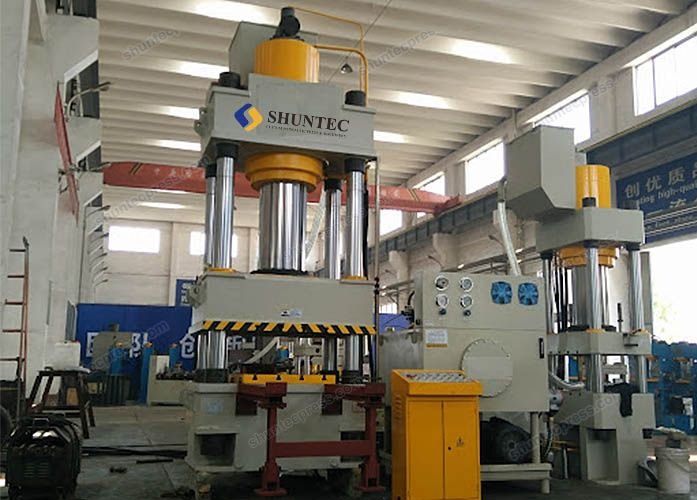

In order to make sure that you purchase the right 300-ton four-column hydraulic press which can reach your expectation of performance and effectiveness and which can be brought into full play in your routine manufacture, you should fully consider the following matters before you make your purchasing decision.
1. Understand The Characteristics Of Different Four-Column Hydraulic Press Manufacturers
At present, there are more and more manufacturers who can offer 300-ton four-column hydraulic presses. In order to exploit the machine’s advantages to the full in the production and processing industry, and make your specific needs satisfied, it is necessary that you understand the characteristics of different brands and confirm whether their prices are reasonable.
The four-column hydraulic press is a kind of equipment that uses an oil pump to transport hydraulic oil for processing operations. It is applicable to the processing of metals, plastics, and rubber, etc., and the effect is fairly good. Some of the advantages of a four-column hydraulic press are as follows:
First of all, it saves costs on mold use. Since a complete set of molds can satisfy the need for processing, costs on mold use can be reduced to a minimum.
Secondly, it can reduce the need for subsequent processing. Nowadays hydraulic presses have been developed to such a high level that they can not only fulfill their own routine duty but further complete the processing of the material as well. Therefore, manufacturers can be saved part of the subsequent processing and reduce production costs.
A four-column hydraulic press has a very stable performance. In actual application, it can reach high working efficiency and production accuracy.
2. Determine Your Specific Product Requirements And Processing Technology
Since the four-column hydraulic press has many specifications and models, before you choose your manufacturer and model, you should determine your specific needs of product function. Consider your own application environment so that the machine you choose can serve your purpose to the best. Choose the right model according to your requirement of production technology, so that the production can be more professional.
Shuntec is a custom 4-column hydraulic press machine manufacturer for years. We build every 4-column hydraulic press directly to your specifications and your unique application. Feel free to contact us when comes to a 4-column hydraulic press.
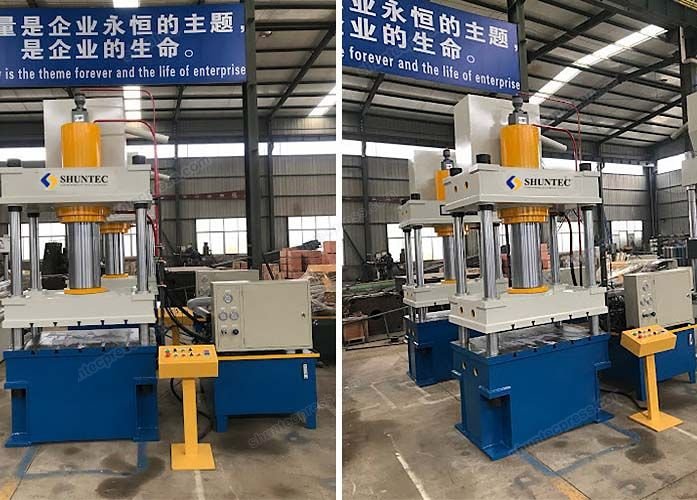

Use Purpose
Shuntec 200 ton four-column hydraulic press is a common machine model used in many industries. Usage includes forging, stamping, cold extrusion, straightening, die-cutting, aluminum sheet stretching, aluminum product die forming, and stainless steel product dies forming.
Structure
Shuntec 200-ton four-column hydraulic press is composed of an upper beam, a sliding block, a worktable, a four-post rod, the main cylinder, a hydraulic power system, and an electrical system. The upper beam, sliding block, and worktable are welded with high-quality steel plates, and the internal stress is eliminated by vibratory stress relief. The surfaces of all four columns are medium-frequency quenched and chrome-plated.
Features
1. Three-stage speed control of the movable beam: fast approaching speed, slow pressing speed, and fast return speed.
2, The main cylinder and the press cylinder have upper and lower limit protection, and the setting of the upper and lower limit positions is simple, convenient, and fast, either by the position limit switches or via HMI.
3. Safety protection methods to ensure safe operation.
4. Low energy consumption, high efficiency, novel styles.
Performance
1. The lower cylinder plunger is replaced with the structure of hard chromium-plated steel and wear-resistant ring to avoid the problem of plunger cracking.
2. The sealing ring of the lower cylinder adopts an imported combination ring, which can last for more than 15 years without replacement.
3. Columns and piston rods are all treated with intermediate-frequency heat treatment, and the surface is hard chrome-plated.
4. The material ejecting cylinder can be individually jog controlled.
5. The hydraulic system uses a cartridge valve. Cartridge valve has a large passage which has the advantages of large flow, high speed, low noise, and low heat.
6. Electrical control is realized by a single-chip microcomputer. The advantage of this system is that it has a safe control voltage of 24V. There is no intermediate relay.
6. The whole computer chip has high stability, long service life, and simple operation.
7. A wide range of grating safety protection devices.
Feel free to contact us for more details about the Shuntec 200 ton four-column hydraulic press.
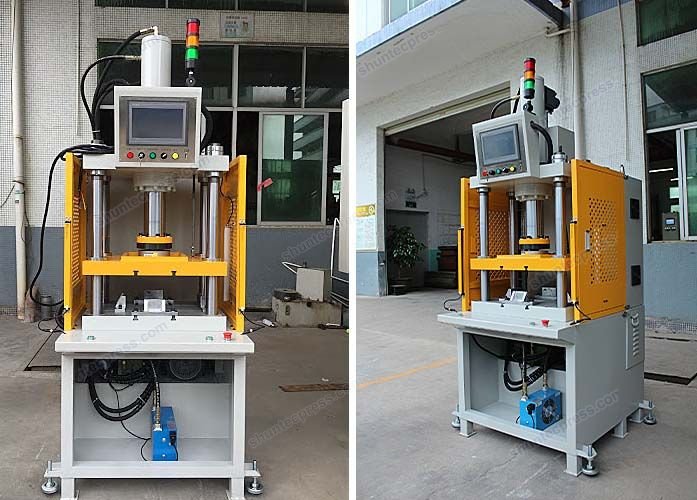
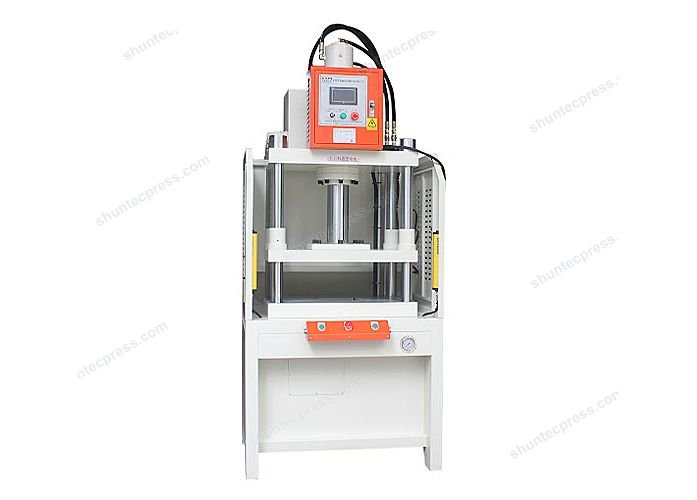
When The Servo-hydraulic Press Machine Is Working, If The Oil Temperature Rises Too Fast, It Will Cause A Series Of Adverse Effects For The Hydraulic System.
The temperature-rising and heating of the hydraulic system is a kind of comprehensive failure, just like pollution. It is mainly measured by testing the oil temperature and some hydraulic components. Temperature-rise will seriously affect the operation of the hydraulic system in the following ways.
1. It will increase the leakage of the servo-hydraulic press machine, and the volumetric efficiency of the pump and the whole system will be significantly reduced.
2. It will cause thermal deformation of the machine, which not only makes the gap between the moving parts with different thermal expansion coefficients in the hydraulic components become smaller and thus causes the parts to get jammed and causes malfunction, but affects the accuracy of the hydraulic equipment as well, resulting in poor parts processing quality.
3. It will also deform the rubber seals of the servo-hydraulic machine, causing premature aging and failure and reducing the service life.
It will not only invalidate the rubber seals but cause leakage as well, which will, in turn, cause further heat generation and temperature rise.
4. If the oil temperature of the servo-hydraulic press is too high, it will accelerate the process of oxidative deterioration of the oil, under which condition the pitch will be released, the service time of the hydraulic oil will be reduced.
5. As the oil temperature of the servo-hydraulic machine rises, the air separation pressure decreases, and the dissolved air escapes from the pump, resulting in cavitation, which lowers the working performance of the hydraulic system.
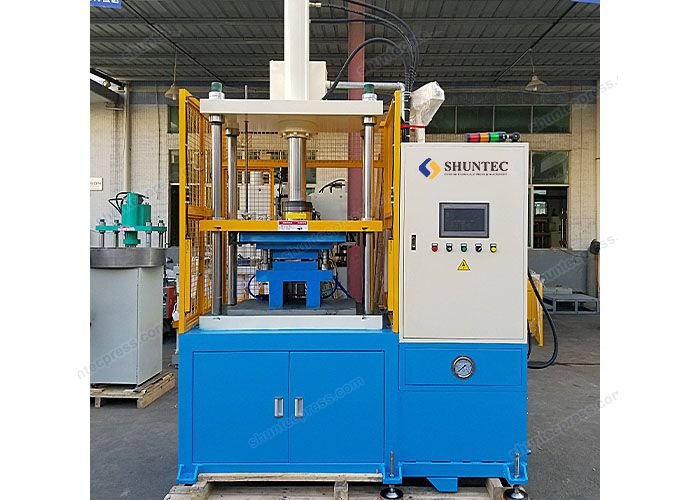

1. Structure
1) The machine body of the servo-hydraulic press can be designed in any of the traditional frame structures such as 2-post, 4-post, benchtop, c frame, etc., which are simple and compact and only takes up small area.
2) The common type of the main cylinder is a piston-type oil cylinder with a fast cylinder inside, which can achieve high-speed downward movement and slow-speed pressing of the down-acting stroke. The double-start operation is safe and very convenient.
3) Any location through the whole journey can be positioned by an electronic ruler. High-precision positioning adopts a mechanical dead limit, and the theoretical positioning accuracy is ±0.01mm, whereas the actual positioning accuracy ranges from 0.01-0.02mm.
4) The electrical system adopts the mode of PLC + servo
System + touch screen + proportional drive, and in collaboration with the proportional hydraulic system, it gives instructions according to specific process requirements to complete cycles of actions.
5) Multiple groups of parameter programs can be accessed freely from the friendly human-machine interface.
6) Pressure is detected by a pressure sensor, and the machine pressure can be set according to actual needs.
7) The servo-hydraulic press machine is optional with a shuttle worktable, which can move in and out of the working area automatically for automatic feeding.
8) The pressing speed is fast, and the pressing cycle of a single product takes only 4-5 seconds.
2. Application
1) The servo-hydraulic press can be used for pressing operations in such areas as motor, auto parts, home appliances, and electronics industries.
2) Used in constant pressure system.
3) Used in compression and extension test system.
4) Embossing, forming, shallow drawing, shaping, and pressure fit of metal or non-metal parts. Pressing of glasses and hardware products.
5) The wide range of applicable products includes watch cases, glasses, mobile phone products, tableware, signs, jewelry, parts, etc.
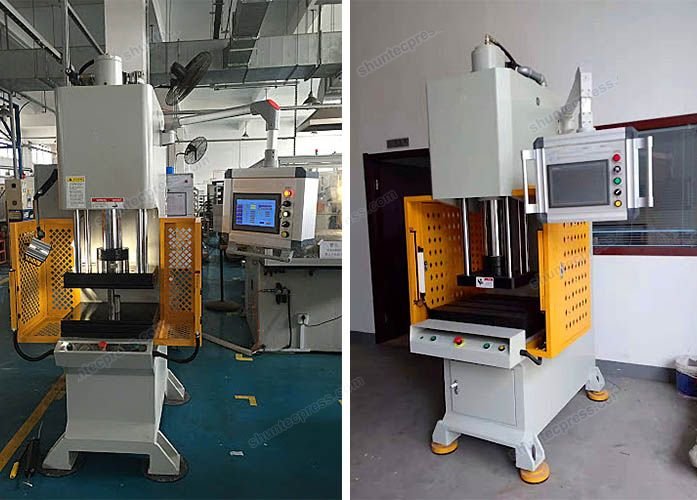
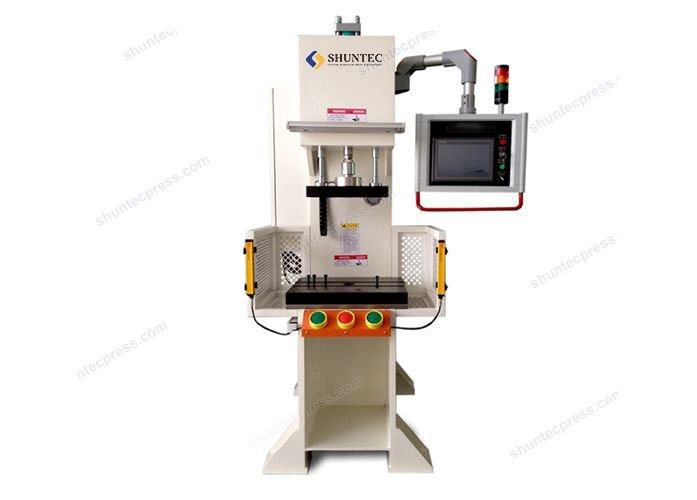
Servo press machine, as a new technology, has advantages that traditional hydraulic presses do not have. In automotive manufacturing processes, such as cylinder head valve seat ring and pipe press fitting, cylinder waterway blanking cap press fitting, transmission bearing press fitting, wheel hub assembling, and others, the servo press machine is gradually taking place of traditional hydraulic presses and has significantly improved the level of the automobile manufacture process.
Analysis Of Advantages
1. High Efficiency And Energy Saving
There is no energy consumption caused by clutch friction and flywheel idling. What’s more, the motor itself is of high efficiency, which makes the servo press machine highly efficient and energy-saving.
2. Intelligent Automatic Numerical Control
The operation of the press is controlled by a high-speed computer intelligent numerical control system, which can be fully automated without resorting to manual operation.
3. Long Service Time Of Mold
The pressure is numerically controlled, so the mold will not be overloaded, worn, or damaged.
4. The Products Are Precisely Formed, With Small Tolerances And High Precision
The pressure is under stable numerical control, and the mold wear is reduced to a minimum. The products are precisely formed under precise numerical control. The forge pieces have no/few trimmings, tolerance is small, and precision is high. No/few cutting is needed. Subsequent processes such as milling and digging are also not needed. With such capability, stud gear and bevel gear can be directly shaped and produced.
5. High Reliability
The servo press has no quick-wear parts, the motor rotor has neither windings nor conductors and not to mention permanent magnets. It is stronger than permanent magnet servo motors, sturdy, reliable, and shock-resistant. The equipment is maintenance-free and thus does not entail any maintenance personnel and working hours.
6. Intelligent Mold Adjustment
The machine body is equipped with a tonnage sensor, which can adjust and test the mold under pressure control. When the slow-speed mold adjustment and short-distance mold alignment are performed, the machine will not be caused to stop. And for mold adjustment and trial, no special equipment and personnel are needed, which saves human resources and working hours.
7. Information Management
The process parameters are numerically controlled in real-time and feedback is given by the communication network in real-time, which realizes the information control of product quality and the traceability of product quality.
8. Resource-saving And Environment-friendly
No permanent magnet rare earth materials are needed, which saves rare and valuable resources and avoids damage to the environment caused by the mining of rare-earth.
9. The Human-machine Interface Has Good Interaction
The motor is numerically controlled. In this way, the user can only input simple displacement and speed parameters to realize the numerical control of an intelligent flexible process curve. The users do not need to compile the process curve by themselves, which shows the great convenience of the machine.
10. The Structure Of The Equipment Motor-deceleration Mechanism-brake-working Unit Is Extremely Simple And Concise, And The Cost Is Low.
With the rapid development of modern industry, the automated production equipment for servo presses is gradually developing towards intelligence, flexibility, energy-saving, high precision, high quality, and high safety.


Compared with traditional hydraulic press machines, servo-hydraulic press machines have the advantages of energy-saving, low noise, high efficiency, and convenient maintenance. The specific analysis is as follows:
1. Energy Saving
Servo hydraulic press, according to different processing techniques and production cycles, the servo-hydraulic press can save power by 20% to 60%.
(1) When the slider is quickly descending and the slider is stationary at the upper limit, the servo motor does not rotate, so no electric power is consumed. By comparison, the motor of the traditional hydraulic press still rotates at the rated speed and still needs to consume 20%-30% of the rated power.
(2) In the pressure holding stage, the servo motor speed of the servo-hydraulic press machine only supplements the leakage of the pump and the system. The speed is generally between 10 pm and 150 pm, and the power consumption is only 1% to 10% of the rated power.
(3) The efficiency of the servo motor is about 1% to 3% higher than ordinary ones and thus is more energy-saving.
2. Low Noise
Servo hydraulic oil pumps generally use internal gear pumps, while traditional hydraulic machines generally use axial plunger pumps. Under the same flow and pressure, the noise of internal gear pumps is 5dB~10dB lower than that of axial plunger pumps.
3. Less Heat Emission And Thus Reducing Cooling Costs
The hydraulic system of the servo-hydraulic machine has no overflow heat, and there is no flow when the slider is stationary, so there is no hydraulic resistance heat. The heat emission of the hydraulic system is generally only 10% to 30% of that of a traditional hydraulic machine.
4. Less Hydraulic Oil Consumption
Because the pump is at a state of zero speed and low heat emission most of the time, the oil tank of the servo-hydraulic machine can be smaller than that of the traditional hydraulic machine, and the oil can be used for a longer time. Therefore, the hydraulic oil consumed by the servo-hydraulic press machine is generally only about 50% of the oil consumed by the traditional hydraulic machines.
5. Fully Closed-loop Digital Precision Control
Servo hydraulic press machine is featured by a high degree of automation, good flexibility, and high precision. On one hand, the pressure, speed, and position of the servo-hydraulic press are fully closed-loop digital controlled, with a high degree of automation and good precision. On the other hand, its pressure and speed are programmable to meet the needs of various processes.
6. High Efficiency
Through proper acceleration and deceleration control and energy optimization, the control speed of the servo-hydraulic machine can be greatly improved, and the work pace, which can reach 10/min~15/min, is several times higher than that of the traditional hydraulic machine.
7. Convenient Maintenance
The hydraulic system is greatly simplified due to the elimination of the proportional servo hydraulic valve, speed control circuit, and pressure control circuit in the hydraulic system. The cleanliness requirements of hydraulic oil are much lower than hydraulic proportional servo systems, which reduces the impact of hydraulic oil pollution on the system.
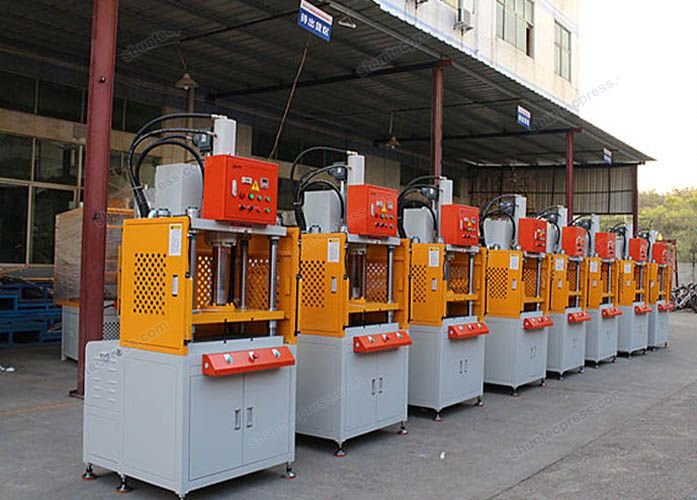

The Hydraulic Press Machine Is One Of The Most Widely Used Equipments In Product Molding And Manufacture. Since its appearance in the 19th century, it has developed very quickly. Due to its wide adaptability, the hydraulic press has been extensively used in various sectors of the national economy. As the hydraulic system and the structure of the hydraulic press are relatively mature, the current development of hydraulic presses at home and abroad is not only reflected in the control system but mainly manifested in the following four aspects as well:
The first aspect is high speed, high efficiency, and low power consumption.
The second is its integration of mechanics, electronics, and hydraulics which help to perfect the whole hydraulic system by fully and reasonably using advanced mechanical and electronic technology.
The third one is its automation and intelligence which can realize automatic diagnosis and adjustment of the system and pretreatment of malfunction.
Last but not least, the hydraulic components are integrated and standardized to effectively prevent leakage and pollution.
As the two major components of the hydraulic press, the main engine, and the hydraulic system, due to the maturity of technology development, there is no big gap between domestic and foreign models. The main difference lies in the processing technique and installation. Good craftsmanship has obviously improved the function of filtering, cooling, and shock & vibration prevention. In terms of oil circuit structure design, hydraulic machines at home and abroad tend to adopt integrated and closed designs. Cartridge valves, superimposed valves, and composite components and systems are widely used in hydraulic systems. In particular, the integrated block can realize professional production, and what’s more, it has premium quality, reliable performance, and a short design cycle.
In recent years, the circuit composed of new hydraulic components developed on the basis of the integrated block also has its unique advantages. Since it does not require additional connectors, its structure is more compact with a relatively smaller volume and lighter weight. No pipe connection is required and thus eliminates leakage, vibration, and noise caused by oil pipes and joints. The logic cartridge valve has the characteristics of small size, lightweight, good sealing performance, low power loss, fast action speed, and easy integration. It appeared in the early 1970s and has since developed rapidly.
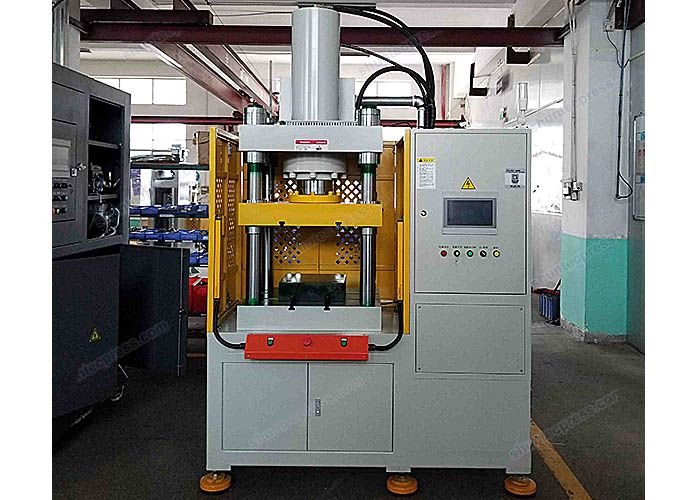

Servo Hydraulic Press Is A New Style Of Electric Pressing Equipment. In the line of punching and press fitting products, servo-hydraulic press stands out with its advantages of high precision, intelligence, flexibility, power efficiency, and stability. It is commonly used in the press-fitting operation of such areas as auto parts, engine pack, circuit board, motor bearing, scientific research, and special units. Industry insiders should know and grasp the common knowledge of servo-hydraulic press with a conscientious attitude, which will otherwise affect the overall understanding of the product and project. In view of the above, we introduce the following common knowledge of servo-hydraulic press:
1. Which frame structure should servo-hydraulic press adopt? Welding structure or cast structure? What is the difference between them?
Servo hydraulic press with welding structure has greater pressure bearing capacity than that with cast structure, so large-scale or high-duty servo-hydraulic press generally adopt welding structure.
2. What material is the stamping mold cutter made of?
The stamping mold cutter in the servo-hydraulic press is generally made of carbon or alloyed tool steel. The carbon tool steel or alloy tool steel has to undergo heat treatment to reach HRC60 hardness, otherwise, they can not be used for the cutter.
3. What is the cushion block of the servo-hydraulic press made of?
The cushion block of servo-hydraulic press is generally made of concrete.


.jpg)
IMT (Inner Molding Translate label) or (Insert Molding Three-dimensional) is a synthesis and extension of in-mold injection molding technology and in-mold transfer printing technology.
It brings together the advantages of a variety of decoration processes: it adopts the advantages of the IML process in the production of the film, absorbs the advantages of the IMR process, and combines the digital printing and offset printing effects with the traditional screen printing process, which makes it highly adjustable and widely applicable, and makes up for the limitations of traditional exterior decoration technology and meets the high-level innovation requirements of product exterior decoration. The 3D effect and product stretching meet the in-mold decoration process of more products.
The advent of the IMT technology process will replace oil spraying, UV overprinting, electroplating, vacuum color plating, silk screen printing, pad printing, transfer printing, and other processes, and will drive leapfrog innovation in the product appearance industry. It has realized three-dimensionality, color gradients, R angles, and other irregular product appearance decoration effects. It has also provided better innovation and realization platform for the exterior design industry.
Plastics Are Reborn In 5G Era
The 5G era is coming, and the mobile phone housing materials will change from plastic to metal and then back to non-metallic materials. Plastics are favored by the low-end market because of their low cost. But now the new IMT process has made plastic the favorite choice of many CMF designers. We cannot evaluate the specific cost of the back cover material alone but should integrate it with the middle frame as a whole to position the price of the product. There are several types, from low-end to high-end mainly including plastic + metal middle frame, 2.5D glass + metal middle frame, 3D glass (ceramic) + metal middle frame.
IMT High Pressure Forming Machine
The IMT high-pressure forming machine is a brand-new numerical control device. It is written by configuration software and uses a high-color touch screen as a carrier to form a friendly human-machine dialogue window, which greatly facilitates users’ visual input and use of production parameters and direct monitoring of on-site production process data including equipment status, forming integrated equipment of oil pressure, position, air pressure, and IR hot pressing.
IMT Technology Application
The name of the traditional IMT process appeared in China back in 2006. In fact, it is similar to the IMR process in Japan. The process at that time was equivalent to the PET carrier of the IML process after its color is removed and left in the plastic part. The radian of products was then not large(2D), and the appearance is not varied enough; basically there were only silkscreen and color layers, very few metallic colors.
The new IMT technology is combined with the most popular 3D optical texture + PVD decoration method. Products processed by this new technology have a more beautiful appearance and larger radian compared with products processed by traditional method. Currently, the new IMT technology has evolved from 3D optical texture + PVD to double 3D optical texture +PVD.
For mobile phone housing made of plastic + metal middle frame, it is the amount of metal CNC processing that determines the price of the whole housing. Compared with the high-pressure composite plate which was very popular last year, the IMT back cover can not only serve as a decorative part, but also a part of the structural part as well, and so as to reduce the processing time of the middle frame. Therefore, it is quite competitive in the 5G era.

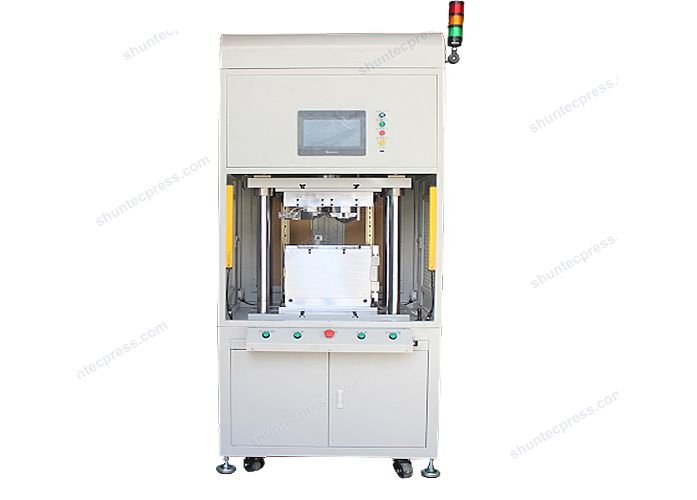
Servo-electric press advantages
1)Real-time monitoring and real-time control. The servo-electric press adopts a modular design, closed-loop control system, which can ensure 100% quality throughout the assembly process. It can achieve and output the curve of force and displacement monitor, force and time monitor, with press control, displacement control, and rate control.
2)High accuracy. With servo-electric press, the press-fitting precision is less than 1%, and part precision is ±0.01 mm.
3)Discrimination and traceability. Instantly collect data and output force and displacement curve diagrams, configure a size identification dialog box, and automatically identify the pressing results.
4)Easy to use and easy to integrate. The Shuntec servo press is equipped with a 12-inch industrial touch screen, easy integration, and convenient data setting and saving.
5)Strong rigidity. The servo press is suitable for press-fitting work.
6)Safety, energy-saving, and environmental protection. The electric servo press is 70% more environmentally friendly and energy-saving than the conventional hydraulic press, and 90% more environmentally friendly and energy-saving than the pneumatic power source machines. The maintenance is low-cost, and the product cost can be further reduced.

